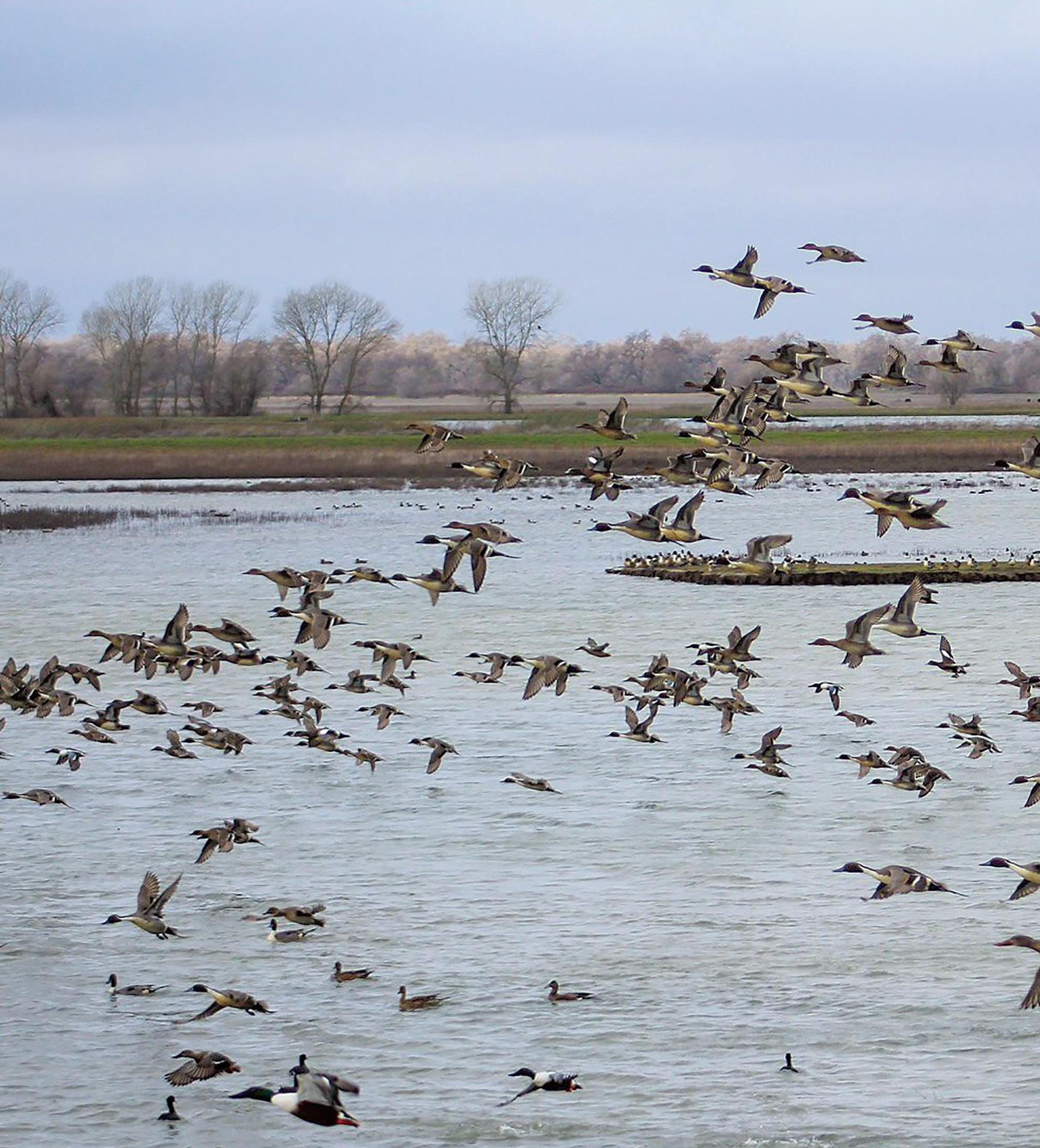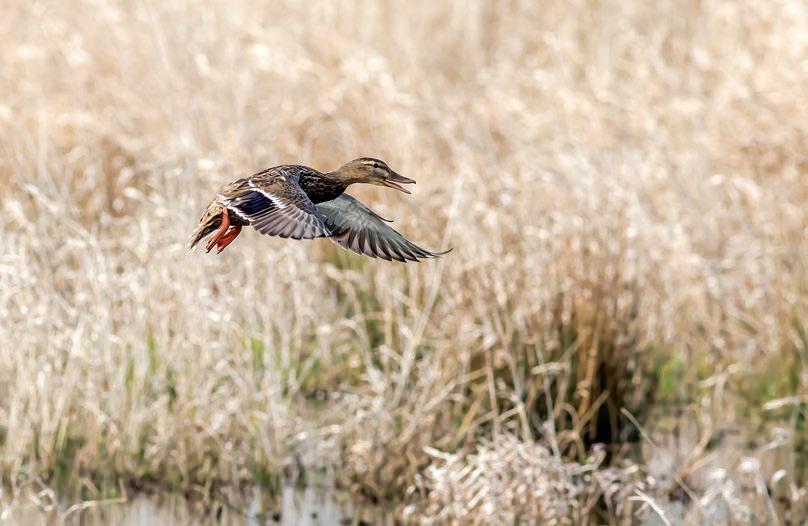
11 minute read
H.I.P. PROGRAM HELPS BIRD HUNTERS
H.I.P. CHECK
LONG REQUIRED FOR MIGRATORY BIRD HUNTERS, THE HARVEST INFORMATION PROGRAM COLLECTS KEY DETAILS ON WATERFOWL AND OTHER FAR-FLYING FLOCKERS, INFORMING MANAGEMENT DECISIONS.

A mixed flock of waterfowl fly through a Northern California wetlands area. The federally implemented Harvest Information Program has provided valuable data for migratory bird hunting managers since it went nationwide in 1998. (REBECCA FABBRI/USFWS)
By M.D. Johnson
Alot of things in life can be complicated, such as taxes and fuel-injected car engines. Fortunately for those hunters who pursue migratory game birds each fall, the Harvest Information Program needn’t be on this list of complications. HIP? What’s that? Glad you asked.
INTRODUCED INITIALLY AS a pilot test in 1992 in California, Missouri and South Dakota, HIP became a national requirement of all those hunting migratory birds in 1998.
“HIP is a program that allows biologists to estimate how many migratory birds – e.g. ducks, geese and doves – hunters harvest in this country each year,” said Karen Waldrop, Ph.D., and chief conservation officer for Ducks Unlimited (ducks.org). “It also tells us how many people are participating in hunting these species.”
It’s a cooperative partnership between the U.S. Fish and Wildlife Service and state game agencies, whereby two important pieces of information are gathered. First is identifying the nation’s migratory bird hunters, and second: what types of migratory birds do these individuals pursue? Note the emphasis on the phrase migratory bird hunters and not exclusively waterfowl hunters. We’ll get to that distinction in a minute.
But getting HIP-certified is only step one in a potentially two-step process. That’s because not every migratory bird hunter will progress to the second step, a much more indepth harvest survey distributed by the USFWS.
The key word here is harvest. While HIP tells the states and the USFWS who the hunters are and what they hunt – ducks, coots, swans, snipe or doves, to name just a few birds – the in-depth survey provides accurate harvest information, such as how many and what species.
That’s HIP in a nutshell.
NOW, WHO NEEDS to sign up for the program? This one’s simple – every hunter who pursues migratory birds must sign up for HIP. Who collects this information? How is it obtained? We’ll get to that momentarily, but for now let’s define migratory birds.
Does this term mean only waterfowl – that is, just ducks and geese? Perhaps incorrectly, HIP has become associated more closely with waterfowl hunters. However, the program applies to much more than just duck and goose hunters.
The USFWS definition of migratory game birds includes any species of, well, migratory bird, including not just ducks and geese, but coots, brant, swans, doves, woodcock, rails, snipe, sandhill cranes, moorhens, bandtail pigeons and gallinules. For all of these birds there is a set season.
But wait, some California hunters might say, “If I only hunt ducks and geese – no snipe or rails, nor moorhens or gallinules, whatever in the heck moorhens and gallinules are – why is it that I have to answer questions about those species?”

“(USFWS needs) to be able to contact people who hunt various birds,” said Frank Rohwer, president and chief scientist of Delta Waterfowl (deltawaterfowl.org). “What this does is it narrows the field and allows the USFWS to ask more detailed questions about what was harvested. They can even ask hunters to send in wings to help determine age, sex and other important data.”
One more note: Once HIP certification is complete, proof of that completion must be carried with the hunter in the field, and, like a hunting or fishing license, must be presented to a wildlife officer representing either state or USFWS offices upon their request. This proof of completion varies from state to state, and it’s the responsibility of the hunter to make sure he or she is HIPcertified and possesses the necessary documentation while afield.
WHO COLLECTS THIS info? When? Is there a cost?
Today, HIP information is gathered in a variety of ways, depending upon
Data for HIP is often collected as a hunter buys a new license, though in some cases that’s not always as reliable a source of information as it could be – for example, the customer service counter at big box stores, where the impetus is to get through as many people as quickly as possible. (JULIA JOHNSON)
the state where HIP is completed. Often, this process is conducted either at the time a hunting license is purchased at a store, online or via a state-specific toll-free telephone number following the purchase of a hunting license.
At the license counter, the license agent should ask the HIP questions as part of the licensing process. If he or she does not, inquire as to the state requirements regarding HIP.
“I usually buy my hunting license at a big box store, and I’ll call them out,” Rohwer said without hesitation. “I’ll say, ‘Hey, I just got HIP-certified, and you didn’t ask me any of the questions.’ I know there are questions and I want to answer them because I want to be a responsible hunter.”
As for cost, the answer is yes or no. In some states, California and others on the West Coast, for example, HIP certification comes free or as part of the license purchase price. Other states like Idaho and New Jersey charge a nominal fee designed to cover any administrative costs. Any cost, then, depends entirely on the state that


issues the hunting license and HIP certification.
H.I.P. CERTIFICATION IS only the first piece of the puzzle. The next step of this twostep process is just as basic. The name of every HIP-certified hunter in a state is placed into a general pool. It’s the computerized equivalent of a spinning drum, so to speak.
From this single drum or pool, a small number of hunters’ names are selected at random each year, and these individuals are asked to complete a much more in-depth survey; that is, the national harvest survey. Think of it like winning the lottery. These surveys are broken down into five separate categories: waterfowl (ducks, geese, sea ducks and brant); doves and bandtail pigeons; American woodcock; snipe, rails, gallinules and coots; and sandhill cranes.
Responses to the HIP questions allow the proper survey to go to the appropriate hunter. That means that duck hunters receive duck surveys, dove hunters receive dove surveys, and
Better management of migratory bird hunting requires better data. Fowl populations, including mourning doves, are high at the moment, but haven’t always been that way, making HIP an important part of setting seasons that provide opportunity while guarding against downturns. (JULIA JOHNSON)
so on. It’s important to note, however, that the occasional duck hunter might receive a dove survey, or vice versa, in order to try to sample hunters who have switched from one to the other.
The national harvest survey asks hunters to maintain a voluntary hunting record throughout the course of the hunting season. Think of it as a hunting journal or diary. For example, our Hunter X, now known to be a duck hunter by virtue of his or her HIP responses, will provide information that includes the date, county of harvest and number of ducks harvested, including any birds downed but not retrieved.
There is a third step to the process, known as the Parts Collection Survey, or more commonly, the Wing Survey. A still smaller subset of hunters will be asked to provide one wing from each bird harvested during the season. With these, researchers can determine species, sex and age for ducks harvested, as well as other limited information for migratory bird species. This gives managers important indications of the health of bird populations in addition to determining how many are harvested.
There’s a saying in the computer world: “garbage in; garbage out.” It means one only gets out of the machinery what one puts in. Enter inaccurate information, and, to no surprise, the information received as a result is likewise erroneous. Similarly, wildlife managers stress the importance of having accurate HIP data in order to build upon that foundation.
“We use the information we get to estimate harvest,” begins Kathy Fleming, chief of the branch of data management and monitoring with the USFWS. “Those estimates are very dependent on the data we get and the size of those samples, so not only do we get an estimate but we want to know how accurate that estimate is.”
IT’S NO SECRET that wildlife management agencies today are being challenged to do more with less. And as agencies try to be more responsive to these challenges, HIP faces its own set of trials.
“The number of hunters has been declining, and most people are familiar with that fact,” Fleming said. “And HIP is our main source of information as a sample framework for our harvest surveys. Over the past 10 years, (survey) participation has declined across the board. People are inundated with requests to take surveys, so that’s negatively impacted our sample in that we (now) have a smaller number of hunters for our surveys, while we also have a lower response rate from those hunters selected. That’s our number one concern going forward for HIP.”
But, you might be asking, what does HIP mean to me, the individual being asked to participate in this annual series of inquiries?
“The vast majority of hunters who participate are doing so because they know it’s important,” Fleming said. “They understand why it’s important as hunters. And we view our hunters not just as people answering a survey, but as partners in data collection that directly affects their hunting


For the first time since 1955, state, provincial and federal agencies in the United States and Canada didn’t perform the annual May waterfowl breeding population survey, but hunting managers will use long-term data to inform flock counts and wetland conditions. (CHAD ZOLLER)
WATERFOWL BREEDING, HABITAT SURVEY CANCELLED DUE TO COVID-19
The U.S. Fish & Wildlife Service cancelled the annual Waterfowl Breeding Population and Habitat Survey for the first time in its 65-year-history, due to restrictions stemming from the coronavirus outbreak.
The report came from Ducks Unlimited, which said the cancellation will not affect the 2020-21 hunting season.
This survey has traditionally involved state wildlife agencies and the Canadian Wildlife Service. Not only was this survey cancelled, but USFWS and CWS also won’t participate in the American Woodcock Singing-ground Survey, Mid-continent Population Sandhill Crane Survey, and Arctic Goose Banding Program. And the U.S. Geological Survey cancelled the North American Breeding Bird Survey, data from which is also important in monitoring bird abundance and regulating harvest of some species, the DU announcement said.
There is good news, however. According to Ken Richkus, chief of the USFWS Division of Migratory Bird Management, the agency will be using “long-term” data and models to produce a forecast for this spring’s duck numbers and habitat conditions.
“Decisions to cancel the May survey and other migratory bird monitoring this spring were based on our priority of protecting the health and safety of the American public, our partners and our employees,” Richkus said.
Another factor in this process is the current travel restrictions in Canada. They may affect some of the goose banding efforts.
Ducks Unlimited Chief Conservation Officer Karen Waldrop had this to say: “These surveys are the bedrock of effective harvest management in North America and have helped sustain waterfowl populations and abundant hunting opportunities for over 60 years. Although we will miss the anticipation and excitement that comes with the annual release of the May survey results, we don’t expect the cancellation of surveys to impact seasons and bag limits for the majority of species. The combination of healthy, robust waterfowl populations and our long-term experience with these data gives us faith that the waterfowl management community can project populations with a high level of certainty.” –Dave Workman opportunities. So it’s different from a survey that asks, ‘What did you watch on TV last week?’ We’re actually asking hunters to provide us with scientific data on their harvest.”
When asked what would be tangible benefits for the migratory bird hunter, Fleming said, “I would say there are a lot of benefits to hunters for providing quality information. Hunters and the public want us to make wise decisions about managing migratory birds, and that’s the number one thing we can do with good information.”
IN CLOSING, A final note: Like the migratory bird hunters upon whom it depends, HIP’s story has been one of evolution; a series of modifications and improvements have been made over the course of its history.
What hasn’t changed since HIP was introduced nationwide in 1998 is the importance of hunters providing good information. Seasons, bag limits, hunting zones, unique opportunities and habitat management decisions are all connected to you, the hunter who answers the questions.
“We’ve been in this prolonged period of liberal bird hunting seasons,” said Fleming, “with really good habitat conditions for most species. And I think a lot of hunters don’t know or remember some of the restrictive regulations that were used in the 1970s to 1990s, so they don’t see the need for getting really good information every year. They think there are a lot of birds and, with fewer and fewer hunters every year, that we don’t need good data. But nothing could be further from the truth!”
“Just because we have liberal seasons now doesn’t mean we can relax our need for information. It’s a very important part of being able to set the season framework and have an entire strategy that lets us know when we have to be conservative and when we can be liberal. But that requires data annually, not just every few years.”
So as responsible hunters, we’re in this together, and it all starts, each year, with each of us getting HIP-certified. CS











